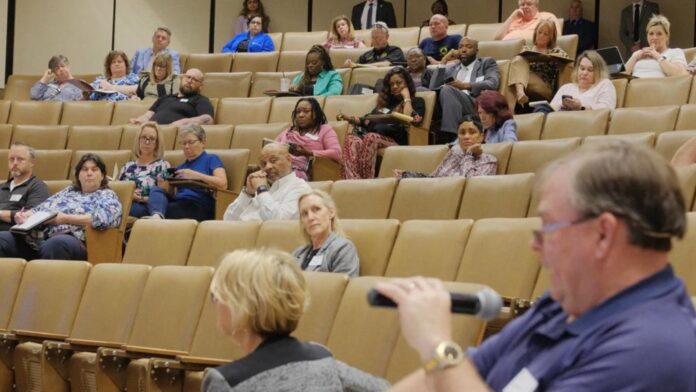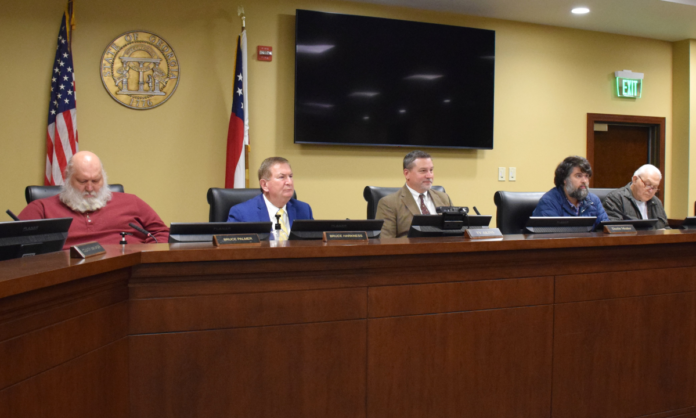The Habersham County Commission will consider two items that have been discussed numerous times over the years.
The commissioners will be taking into consideration the consolidation of two voting precincts and reconsider a recent vote to demolish the old courthouse located in downtown Clarkesville. Both items will be discussed during the regular commission meeting Monday evening.
Precinct consolidation
Commissioners will consider the consolidation of the Amy’s Creek Precinct off of GA 17 at Fire Station 16 with the North Precinct at the Ruby Fulbright Aquatic Center. They will also consider the consolidation of the Mud Creek Precinct located at B.C Grant Church in Alto with the South Precinct in Cornelia.
According to staff’s recommendations, consolidating voting precincts will reduce some of the confusion on Election Day for voters and will reduce the number of poll workers needed, saving the county a little money.
Amy’s Creek Precinct
The proposed consolidation of the Amy’s Creek Precinct into Habersham North would end voting at the Amy’s Creek Fire Department. The current setup causes significant congestion on Election Day, often blocking fire trucks from accessing the building and restricting firemen’s activities for up to three days. The room where voting equipment is set up has to be closed off to everyone except election workers and poll managers, further complicating operations.
Additionally, officials note that a significant number of Amy’s Creek voters already cast their ballots early, either through absentee voting or during the advance voting period. The change will affect 1,839 registered voters in the Amy’s Creek precinct.
Mud Creek Precinct
The consolidation of the Mud Creek Precinct into the South Precinct would address confusion among some voters who mistakenly go to the South Precinct to vote on Election Day, thinking they can vote there after previously participating at that location during early or advance voting. The change will affect 5,322 registered voters in the Mud Creek Precinct.
Since the two precincts are only about four miles apart, officials believe the change will be relatively simple for voters to adjust to, reducing confusion and ensuring a smoother process. The consolidation also allows the county to streamline operations and reduce the need for additional poll workers, helping to save taxpayer money.
SEE ALSO: Elections Board to discuss voting improvements
The commission in 2012 approved consolidating 14 voting precincts throughout the county down to two, a South Precinct and a North Precinct. Two years after that decision was made, voters experienced long lines and long wait times during the November 2014 general election. Even with technological improvements, a later commission approved expanding the number of county precincts to four. The precincts in Demorest and Mt. Airy are contracted with the county for the convenience of their city residents.
Courthouse demolition
Two weeks ago, demolition of the old courthouse failed by a vote of 3-2. Only Commission Chairman Ty Akins and Commissioner Dustin Mealor voted in favor. During Monday’s meeting, the commission will reconsider whether to demolish the building. The cost of that potential work had recently come down to around $190,000, according to county officials.
At a development authority meeting Thursday, Executive Director with Partnership Habersham Charlie Fiveash said he and Habersham Development Authority Chairman Jim Butterworth had reopened dialogue with Commissioner Bruce Harkness about potential demolition of the structure.
Following his “no” vote last week, Harkness said his opposition to demolition came after he wasn’t given adequate notice a vote would be taken during that meeting.
“I do think that there’s a good chance that’s going to work itself out,” Butterworth said during the meeting. “In retrospect, I wish I had engaged with a couple of the commissioners prior to their vote – to help them kind of understand where we are…I think, if we had, maybe we would have gotten a different answer. I don’t think we’ve lost the war. I think we just lost the battle.”
Butterworth went on to say that he believes there could be different results to come out of a future vote on whether the old courthouse should fall.
Akins and Mealor only need one other commissioner for 3-2 approval to proceed with demolition, making Harkness a critical swing vote.
But, when reached by phone Friday, Dec. 13, Harkness told Now Habersham that he’ll likely vote against demolition again at Monday’s meeting – only because he believes taking that vote, now, is premature.
Instead, Harkness believes that vote should be taken in January after Commissioner-elect Kelly Woodall replaces Commissioner Bruce Palmer.
“I told them I would prefer (the vote) be put off until January when the new commissioner can take office,” Harkness said. “I’d like to have more time to meet with (Woodall) and discuss it with him.”
Commissioner Bruce Palmer said on Friday that so far his stance on the matter has not shifted.
“I’ve made a few calls and sent a few emails that I’m waiting to be returned, but as of now, my position has not changed,” he said.
SEE RELATED: Courthouse demolition will cost taxpayers
Missed grant opportunity
Nearly two years ago, in March of 2023, the Habersham County Development Authority discussed that the county and the city of Clarkesville could apply for a grant to demolish and develop the property. The next month the Authority and county officials determined that the property would sell faster without the building.
At that time, officials looked at possibly securing a Community Development Block Grant to pay for the demolition of the old courthouse and redevelopment of the property. Then- county grant coordinator, Lauren Long, explained to the authority at a meeting in May 2023 that securing a grant would be a long and tedious process. According to DCA, the county would most likely meet the requirements for the grant.
The county did not apply for the grant, and three months later, Habersham County commissioners voted to have the taxpayers pay for the courthouse demolition. If the county had applied for the grant, it would have potentially saved taxpayers hundreds of thousands of dollars since DCA would only require a 5% match (or $25,000) on a half-million dollar grant.
According to Long, DCA looks favorably upon partnership grants. Chances were good such a grant would have been approved.
Palmer was the only commissioner who advocated for the county to seek grant funding for the courthouse demolition. He and Commissioner Jimmy Tench were the dissenting votes at the commission’s August 2023 meeting. Tench advocated for saving the courthouse for future office space and storage.
Palmer expressed his opinion at that time. “Just my opinion, but I think it would have been wise to at least go through the grant process. The worst thing they could say is no.”
Palmer added: “Even if it delayed the project, I think the county, the city, and the development authority would all be better off to pursue a grant.”
Palmer reiterated on Friday that he still believes a grant would’ve gone a long way to save taxpayer dollars.
“If the county had put in for a grant two years ago, the county could’ve done something with it by now,” Palmer said. “It might’ve had to have been some type of housing development (grant), which most of the board (members) are adamant that we shouldn’t be involved in housing. All over the state and the U.S., local governments are involved in housing in their jurisdiction, their county, their city. Just because we haven’t done it before – doesn’t mean we (can’t).”
Other business
The commission will hold two public hearings to hear citizen comments about a conditional use permit and a rezoning classification.
Marjorie Stephens has applied for a conditional use permit for 1.47 acres of property located at 604 Barron Drive. She made the request for the purpose of a dog training facility.
MPE Holdings, LLC has applied to rezone three parcels of property equaling 13.62 acres from Low Intensity to High Intensity. The property is located at the intersection of Alto-Mud Creek Road and GA 365. The purpose for the rezoning is for development of commercial property.
The Habersham County Commission will hold its regular meeting at 6:15 p.m. Monday, December 16. The meeting will be held in the Jury Assembly Room in the Habersham County Courthouse located at 295 Llewellyn Street in Clarkesville.
Now Habersham reporter Brian Wellmeier contributed to this article.












